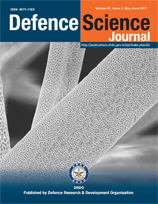Investigation on Semi-active Suspension System for Multi-axle Armoured Vehicle using Co-simulation
DOI:
https://doi.org/10.14429/dsj.67.10820Keywords:
Semi-active suspension, multi-body dynamics, co-simulationAbstract
The objective of the study is to evaluate the performance of various semi-active suspension control strategies for 8x8 multi-axle armoured vehicles in terms of comparative analysis of ride quality and mobility parameters during negotiation of typical military obstacles. Since the cost, complexity and time precludes realisation of actual system, co-simulation technique has been effectively implemented for this investigation. Co-simulation combines advanced virtual prototyping and control technology which offers a novel approach to investigate the dynamics of such complex system. The simulations for the integrated control system along with multi body model of the vehicle are carried out for the control strategies, viz. continuous sky hook control, cascade loop control and cascade loop with ride control and compared with passive suspension system. The vehicle with 8x8 configuration is run on the real world obstacle profiles, viz. step, trench, trapezoidal bump and corrugated road and the effect of control strategies on ride comfort, wheel displacement and ground reaction is presented. It is observed that cascade loop with ride control in semi-active mode offers better vehicle ride comfort while crossing the said obstacles. The improved performance parameters are achieved through stabilisation of heave, pitch and roll motions of the vehicle through outer loop and isolation of vehicle level uneven disturbances through the fuzzy logic controller employed in inner loop.
Downloads
Additional Files
Published
How to Cite
Issue
Section
License
 Where otherwise noted, the Articles on this site are licensed under Creative Commons License: CC Attribution-Noncommercial-No Derivative Works 2.5 India
Where otherwise noted, the Articles on this site are licensed under Creative Commons License: CC Attribution-Noncommercial-No Derivative Works 2.5 India


